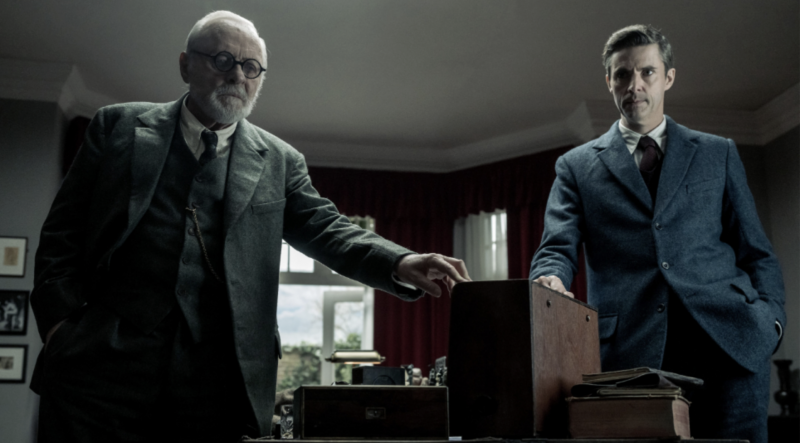
Freud’s Last Session
Studio: Sony Pictures Classic
Director: Matt Brown
Dec 28, 2023
Web Exclusive
![]()
It’s that time of year again, when a faux highbrow, one-room set and conversation-heavy film–usually historical and often featuring Anthony Hopkins–comes out with little audience knowledge or anticipation. This year, that film is Freud’s Last Session, a painfully dull movie that cares about its hypothetical premise much more than coming up with anything meaningful or thought-provoking to impart.
In theory, Freud’s Last Session boasts an interesting premise. Matt Brown’s film is set in 1939, just days after Germany invaded Poland, and tracks a hypothetical session between Sigmund Freud (Anthony Hopkins) and author C. S. Lewis (Matthew Goode). Mostly set in Freud’s office, the two discuss everything from their beliefs on religion–Lewis had a spiritual awakening, to Freud’s dismay–to Lewis’ experiences fighting in World War I. All the while, Freud’s condition deteriorates rapidly throughout their meeting due to his oral cancer.
Alongside this narrative, Freud’s Last Session includes a smaller plotline, following Freud’s daughter, Anna (Liv Lisa Fries), in her professional endeavors and secretive relationship with her partner, Dorothy (Jodi Balfour). The inclusion of this narrative somewhat expands the film’s plot, introducing much-needed breaks to the “Last Session” at hand. But, the extent to which this plotline is explored—taking up just a few scenes within the 108-minute film and nothing more—raises a question of why it’s even there in the first place.
One could apply that question to the entire film. Given that the film’s story, dialogue, and portrayals are centered around a fictional imagining of these two minds meeting, it’s almost baffling how uninteresting and uninspiring the story is. Just 20 minutes into the film, as Freud and Lewis have begun their discussion, their surface-level dialogue and forced interactions make it clear that Brown and his co-writer Mark St. Germain have no further ideas beyond placing these two figures in a room and letting them interact. Any substance is overshadowed by the two characters “playing the hits” of their real-life subjects, rapidly mentioning ideas like samplers for their broader beliefs. Oddly, the film’s hypothetical foregrounding is the most pertinent quality holding it back. Given the story’s fictional conceit, Brown could have easily transcended the two subjects’ backstories to introduce something new, risky, and challenging about how we perceive them in real life. By playing it safe, we emerge from the film learning nothing new or illuminating about either figure, perhaps thanking our blessings that–if this were to be their conversation in real life–they never met.
Freud’s Last Session also suffers from brutally slow pacing. The film almost seems aware of its one-room, one-situation conceit. It constantly employs tactics–such as Anna’s plotline or flashbacks to grander set pieces, like the trenches of World War I–to give viewers a break from the setting of Freud’s office. Unfortunately, these attempts all fall short. With overly simple and unchallenging dialogue, all the film’s sequences move so slowly that their spatial and temporal changes lose all their effects. Instead, it quickly becomes clear that all these efforts are just attempts to distract from the story’s emptiness. When the film lacks anything to maintain viewer attention–a captivating story, a guiding theme, or challenging performances–the emptiness feels even faster. (www.sonyclassics.com)
Author rating: 3.5/10
Current Issue

Issue #72
Apr 19, 2024 Issue #72 - The ‘90s Issue with The Cardigans and Thurston Moore
Most Recent
- 10 Best Songs of the Week: Nilüfer Yanya, Linn Koch-Emmery, Fat Dog, Crumb, St. Vincent, and More (News) —
- Fat Dog Announce New Album and Tour, Share Video for New Song “Running” (News) —
- The Obsessed, Howling Giant @ Brooklyn Meadows, NYC, April 12, 2024 (Review) —
- Premiere: Slow Joy Releases New Single and Video for “King Cowboy” (News) —
- Premiere: Mackenzie Shrieve Shares New Single “Didn’t I Tell Ya” Feat. Jane Bruce (News) —

Comments
Submit your comment
There are no comments for this entry yet.